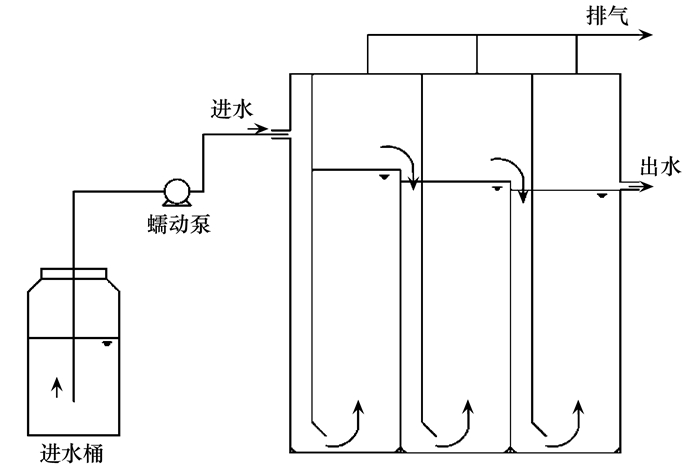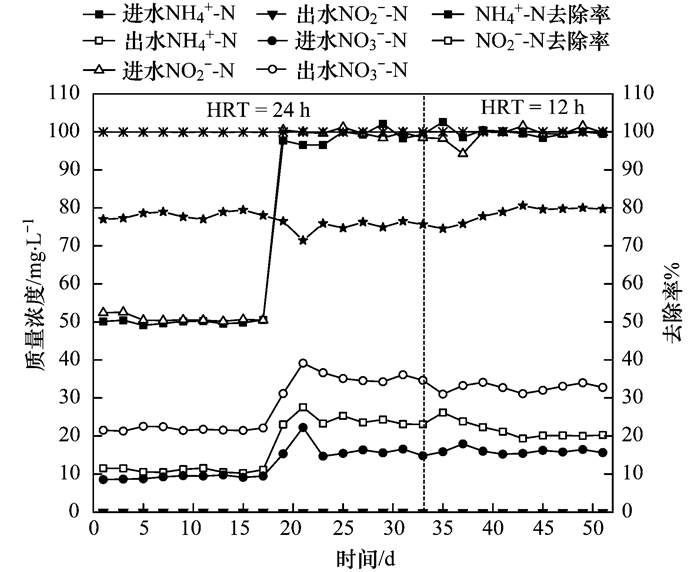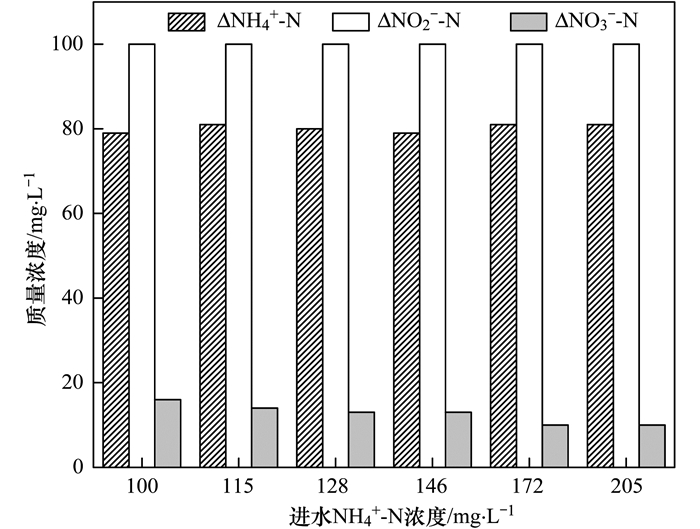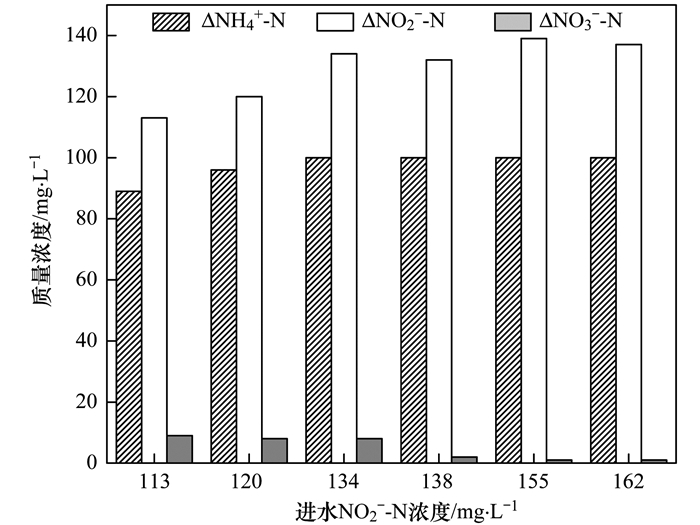2. 江苏省水处理技术与材料协同创新中心, 苏州 215009;
3. 江苏省环境科学与工程重点实验室, 苏州 215009
2. Jiangsu Collaborative Innovation Center of Technology and Material of Water Treatment, Suzhou 215009, China;
3. Jiangsu Key Laboratory of Environmental Science and Engineering, Suzhou 215009, China
厌氧氨氧化 (anaerobic ammonium oxidation,ANAMMOX) 是在厌氧或缺氧条件下,厌氧氨氧化菌以 NH4+-N为电子供体,NO2--N为电子受体,将 NH4+-N和NO2--N直接转化为N2的过程[1].相较于传统脱氮工艺具有无需投加有机碳源、产泥量少、节能等优势[2].目前,学术界普遍接受的厌氧氨氧化反应方程式如式 (1) 所示[3].从中可知,该反应 NH4+-N和NO2--N消耗量与NO3--N生成量理论比为1:1.32:0.26,但在实际运行中,由于反应器运行条件和菌群结构的不同, NH4+-N和NO2--N消耗量与NO3--N生成量并不严格符合理论值.有研究报道的NO2--N和 NH4+-N消耗量之比为0.91~2.0[4, 5],NO3--N生成量与 NH4+-N消耗量之比为0.04~0.41[3, 6, 7].过高或过低的进水NO2--N/ NH4+-N将会造成NO2--N和 NH4+-N的不完全转化,影响厌氧氨氧化工艺的脱氮效率,易致出水水质不达标.因此,进水基质比对于厌氧氨氧化工艺的实际调控具有重大意义.

|
(1) |
众多学者针对厌氧氨氧化工艺的影响因素如温度[8]、pH[9]、溶解氧[10]、有机物[11]、有毒物质[12]进行了大量系统的研究,并形成了一定的共识.但对于进水基质比对厌氧氨氧化工艺的影响研究较少,且研究结果差异较大,Tsushima等[13]研究发现NO2--N/ NH4+-N为0.8~0.87时,反应器去除效率较高. Jin等[14]研究表明最佳NO2--N/ NH4+-N为1.2,此时出水总氮最低.厌氧折流板反应器 (ABR) 具有结构简单、生物截留能力强、运行效果稳定可靠等特点[15],利于厌氧氨氧化菌的富集与生长.近年来,已有部分学者将其应用于厌氧氨氧化工艺研究中[16, 17].本研究采用厌氧折流板反应器 (ABR),通过控制不同的进水NO2--N/ NH4+-N,考察不同进水基质比对厌氧氨氧化脱氮性能的影响,以期为ABR厌氧氨氧化工艺的实际运行和调控提供借鉴和指导.
1 材料与方法 1.1 试验装置试验所采用的ABR (图 1) 反应器由有机玻璃制成. ABR反应器长26 cm,宽9 cm,有效高度20 cm,有效容积4.8 L.分为3个隔室,每个隔室升降流区宽度比为4:1,折流板导向角为45°,采用恒流泵连续进水,溢流出水.反应器整体密封保证厌氧,采用遮阳塑料膜遮住避光,置于恒温水浴缸中,控制水浴温度33℃±2℃.

|
图 1 ABR反应器装置示意 Fig. 1 Schematic of anaerobic baffled reactor |
试验采用人工配水,控制进水pH为7.5±0.5,其成分主要包括 (NH4)2SO4(按需配制),NaNO2(按需配制),KHCO3 500 mg ·L-1,KH2PO4 27.2 mg ·L-1,MgSO4 ·7H2O 300 mg ·L-1, CaCl2 ·2H2O 180 mg ·L-1,微量元素Ⅰ和微量元素Ⅱ按照1 mL ·L-1添加.微量元素Ⅰ组分 (g ·L-1):EDTA 5,FeSO4 5;微量元素Ⅱ组分 (g ·L-1):EDTA 15,ZnSO4 ·7H2O 0.43,CoCl2 ·6H2O 0.24,MnCl2 ·4H2O 0.99,CuSO4 ·5H2O 0.25,NaMoO4 ·2H2O 0.22,NiCl2·6H2O 0.19,NaSeO4 ·10H2O 0.21,H3BO4 0.014.
1.3 接种污泥厌氧氨氧化ABR反应器的接种污泥取自苏州市某污水厂A2/O工艺的好氧硝化污泥,在进行本试验前,该反应器已成功启动并稳定运行30 d[18]. ABR各隔室污泥性质如表 1所示.
|
|
表 1 ABR各隔室污泥性质 Table 1 Character of sludge during stable operation |
1.4 试验方法
整个试验共分为3个阶段,分别记为PhaseⅠ、PhaseⅡ、PhaseⅢ.在PhaseⅠ期间,通过提高进水 NH4+-N和NO2--N浓度或缩短HRT,并控制进水NO2--N/ NH4+-N为1,以提高反应器容积负荷,提高反应器厌氧氨氧化功能.在PhaseⅡ期间,保持HRT为12h不变,固定进水NO2--N浓度为100 mg ·L-1,逐步提高 NH4+-N浓度,使得进水NO2--N/ NH4+-N变化由1~0.5递减,考察 NH4+-N过量对ABR厌氧氨氧化脱氮性能的影响.在PhaseⅢ期间,保持HRT为12h不变,固定进水 NH4+-N浓度为100 mg ·L-1,逐步提高NO2--N浓度,使得进水NO2--N/ NH4+-N变化由1~1.6递增,考察NO2--N过量对ABR厌氧氨氧化脱氮性能的影响.在PhaseⅡ和PhaseⅢ期间,每个工况下反应器至少运行2周,待系统运行稳定后再调整下一个工况.
1.5 测定项目与方法试验过程中每隔2 d采集反应器进出水水样及ABR反应器各隔室水样.测定项目主要包括 NH4+-N、NO2--N、NO3--N、MLSS、MLVSS. NH4+-N:纳氏试剂分光光度法;NO2--N:N-(1-萘基)-乙二胺分光光度法;NO3--N:紫外分光光度法;MLSS、MLVSS采用重量法[19].
2 结果与讨论 2.1 PhaseⅠ:负荷提高期ABR厌氧氨氧化脱氮性能 (进水NO2--N/ NH4+-N =1)在PhaseⅠ期间,采用两种方式提高反应器容积负荷 (见图 2),第1步:控制ABR反应器HRT为24 h, 将反应器进水 NH4+-N和NO2--N浓度由50 mg ·L-1提升至100 mg ·L-1,容积负荷升高为0.2 kg ·(m3 ·d)-1.第2步:固定进水 NH4+-N和NO2--N浓度为100 mg ·L-1,将反应器HRT缩短为12 h, 容积负荷升高为0.4kg ·(m3 ·d)-1.由图 2可知,前期将进水浓度由50 mg ·L-1提升到100 mg ·L-1过程中,反应器出水 NH4+-N浓度由11 mg ·L-1提高到24 mg ·L-1左右, NH4+-N的绝对去除量增加, NH4+-N去除率一直维持在75%以上,出水NO3--N浓度由21 mg ·L-1提高到35 mg ·L-1左右,表明反应器厌氧氨氧化活性得到增强.运行至第33 d时,将反应器HRT缩短为12 h,出水 NH4+-N和NO3--N浓度有所降低但变化不大,进出水浓度变化曲线较为平缓,波动较小. HRT的缩短并未对反应器厌氧氨氧化脱氮性能造成影响,表明ABR反应器具有较强的耐冲击负荷[15].在整个负荷提高期间,出水NO2--N浓度几乎检测不到,去除率保持在99%以上.该阶段后期, NH4+-N和NO2--N消耗量与NO3--N生成量之比逐渐稳定在1:1.26:0.21,与理论值[3]较为接近,表明ABR反应器厌氧氨氧化功能较强.

|
图 2 ABR稳定运行时厌氧氨氧化脱氮性能 Fig. 2 Nitrogen removal performance of the ANAMMOX ABR reactor during PhaseⅠ |
控制进水NO2--N浓度为100 mg ·L-1,逐步提高 NH4+-N浓度,使得进水NO2--N/ NH4+-N变化由1到0.5递减.反应器进出水质变化如表 2所示,不同进水 NH4+-N浓度下 NH4+-N消耗量 (Δ NH4+-N)、NO2--N消耗量 (ΔNO2--N) 与NO3--N生成量 (ΔNO3--N) 如图 3所示.

|
图 3 阶段Ⅱ期间 NH4+-N 、NO2--N消耗量与NO3--N生成量 Fig. 3 Ammonium, nitrite removal and nitrate production during PhaseⅡ |
|
|
表 2 阶段Ⅱ期间反应器进出水 NH4+-N 和NO2--N变化 Table 2 Variation of influent and effluent NH4+-N , NO2--N concentration during phase Ⅱ in the reactor |
根据图 3,随着进水 NH4+-N浓度的提高,即 NH4+-N相对过量的过程中,ABR反应器对 NH4+-N和NO2--N的绝对去除量较为稳定,分别为80 mg ·L-1和100 mg ·L-1左右. NO2--N的去除率一直维持在99.99%左右, NH4+-N的去除率随着进水 NH4+-N浓度的提高逐渐降低,TN去除率也一直下降.厌氧氨氧化的显著特征就是 NH4+-N和NO2--N按照一定的比例去除, NH4+-N和NO2--N同时作为厌氧氨氧化的底物,当 NH4+-N相对NO2--N过量时, NH4+-N的去除量由NO2--N控制,NO2--N的去除量一定时, NH4+-N的去除量也保持不变.然而Jin等[14]在上流式曝气生物滤池厌氧氨氧化系统中固定进水NO2--N浓度为280 mg ·L-1,不断提高 NH4+-N浓度,发现反应器对富余 NH4+-N具有额外吸收的功能,并从化学平衡和微生物协同与竞争的角度给予了解释.本试验中并未出现反应器对过量 NH4+-N额外吸纳的现象.这可能与反应器构造、运行条件和细菌种类有关.
有研究表明,由高氨氮诱发的游离氨对厌氧氨氧化具有抑制作用[20, 21],但 NH4+-N对厌氧氨氧化菌的抑制作用相对较弱[22, 23].本试验中 NH4+-N相对过量并未对ABR厌氧氨氧化脱氮性能产生影响,在该阶段末期,将进水NO2--N/ NH4+-N恢复到1,出水 NH4+-N和NO2--N浓度迅速恢复到该阶段初始状态 (进水NO2--N/ NH4+-N =1),表明整个阶段试验中,ABR厌氧氨氧化菌的活性并未因 NH4+-N过量而受到任何抑制,出水 NH4+-N浓度的提高只是由 NH4+-N相对过量,引发NO2--N底物不足导致 NH4+-N无法去除的简单生物化学现象.
2.3 PhaseⅢ:NO2--N过量对ABR厌氧氨氧化脱氮性能的影响 (进水NO2--N/ NH4+-N =1~1.6)控制进水 NH4+-N浓度为100 mg ·L-1,逐步提高NO2--N浓度,使得进水NO2--N/ NH4+-N变化由1到1.6递增.反应器进出水质变化如表 3所示,不同进水NO2--N浓度下 NH4+-N和NO2--N消耗量与NO3--N生成量如图 4所示.
|
|
表 3 阶段Ⅲ期间反应器进出水 NH4+-N和NO2--N变化 Table 3 Variation of influent and effluent NH4+-N, NO2--N concentration during phaseⅢ in the reactor |
由图 4可知,当进水NO2--N浓度由113 mg ·L-1提高到134 mg ·L-1的过程中 (进水NO2--N/ NH4+-N由1 1.34), NH4+-N和NO2--N的去除量逐渐增大,Δ NH4+-N由89 mg ·L-1提高到100 mg ·L-1左右,ΔNO2--N由100 mg ·L-1升高到134 mg ·L-1左右,表明厌氧氨氧化脱氮功能逐步增强,当进水NO2--N/ NH4+-N =1.34时, NH4+-N和NO2--N的去除率同时达到99.99%左右,总氮去除率达到峰值为87%.继续提高进水NO2--N浓度 (进水NO2--N/ NH4+-N由1.38 1.62), NH4+-N和NO2--N绝对去除量稳定,并未出现明显变化.值得注意的是,本阶段中NO3--N的生成量随着进水NO2--N浓度的提高而逐步减少,尤其是将进水NO2--N/ NH4+-N由1.34提高至1.62的过程中,ΔNO3--N下降显著.在 NH4+-N和NO2--N去除量一定的情况下,NO3--N的产量理应固定不变,但试验结果并非如此,这一现象尚未有研究者提出.作者推测这一现象是由于内源反硝化作用导致的,进水NO2--N浓度的提高刺激了反硝化菌的活性,内源反硝化作用不断加强,使得生成的一部分NO3--N被去除.

|
图 4 阶段Ⅲ期间 NH4+-N、NO2--N消耗量与NO3--N生成量 Fig. 4 Ammonium, nitrite removal and nitrate production during PhaseⅢ |
相较于 NH4+-N,NO2--N对厌氧氨氧化菌活性的抑制作用更加明显[24]. Strous等[5]认为NO2--N浓度超过100 mg ·L-1时会完全抑制厌氧氨氧化菌活性.本阶段试验中 NH4+-N的去除率一直保持在99.99%左右,并未出现任何抑制现象.同样在该阶段末期,将进水NO2--N/ NH4+-N恢复到1,出水水质又迅速达到了初期水准.不同厌氧氨氧化菌种对NO2--N的耐受程度有所差异,Egli等[25]研究发现,Brocadia anammoxidans菌能耐受NO2--N浓度为10 mmol ·L-1,而Kuenenia stuttgartiensis菌的耐受程度为13 mmol ·L-1,反应器中菌群种类与数量的不同是导致NO2--N抑制阈值的主要原因.
本试验中,当进水NO2--N/ NH4+-N =1.34时, NH4+-N和NO2--N达到100%左右,总氮去除率最高,表明本研究中ABR厌氧氨氧化脱氮系统最佳基质比为1.34,与理论值1.32较为吻合.由图 2和图 3可知,过量的 NH4+-N和NO2--N对ABR厌氧氨氧化系统并未产生显著影响,为获得最大总氮去除率,宜将进水NO2--N/ NH4+-N控制在理论值附近.在实际运行中,也可根据 NH4+-N和NO2--N的实际消耗比对进水NO2--N/ NH4+-N作适当调整.
2.4 ABR各隔室脱氮规律各阶段不同工况下稳定运行时进出水水质及各隔室水质如图 5和图 6所示.不管是在 NH4+-N或NO2--N过量的情况下,系统对 NH4+-N和NO2--N的去除几乎都在第一个隔室完成,这与启动成功的ABR厌氧氨氧化氮素去除情况相似[18].由图 5可知,进水NO2--N/ NH4+-N由1至0.49的过程中,第1隔室对 NH4+-N的去除贡献率一直维持在95%以上,其余两个隔室对 NH4+-N的去除贡献率保持在3%左右,而第1隔室对NO2--N的去除贡献率一直保持在99.99%左右.由图 6可知,进水NO2--N/ NH4+-N由1.13至1.34的过程中,NO2--N在第1隔室中已被除尽,第1隔室的出水 NH4+-N逐渐降低, NH4+-N的去除量逐渐增大.随后进水NO2--N/ NH4+-N由1.38至1.62的过程中,第1隔室对 NH4+-N的去除贡献率保持在99.99%以上,NO2--N由于达到饱和状态,第1隔室对NO2--N的去除贡献率降低到98%,其余两个隔室对NO2--N的去除贡献率各占1%左右. ABR特殊的结构使得第1个隔室中富集了大量的厌氧氨氧化菌,承担了主要的脱氮功能,其余各隔室作用微弱.过量的 NH4+-N和NO2--N对ABR各隔室脱氮效果没有产生显著影响,这也表明ABR厌氧氨氧化系统对基质浓度的变化具有较好的稳定性.

|
图 5 阶段Ⅱ期间各隔室水质 Fig. 5 Water quality of each compartment during PhaseⅡ |

|
图 6 阶段Ⅲ期间各隔室水质 Fig. 6 Water quality of each compartment during PhaseⅢ |
(1) 本研究中ABR厌氧氨氧化系统脱氮最佳基质比 (进水NO2--N/ NH4+-N) 为1.34时, NH4+-N和NO2--N的去除率同时达到99.99%左右,总氮去除率达到峰值为87%.
(2) 进水 NH4+-N或NO2--N相对过量时,ABR对 NH4+-N和NO2--N的去除量较为稳定,分别保持在100 mg ·L-1和134 mg ·L-1左右,过量的 NH4+-N或NO2--N对ABR厌氧氨氧化系统没有产生明显抑制.
(3) 不同基质比条件下, NH4+-N和NO2--N的去除基本在第1隔室完成,基质比变化对ABR各隔室的脱氮效果没有产生显著影响,ABR厌氧氨氧化系统对基质浓度的变化具有较好的稳定性.
| [1] | van de Graaf A A, Mulder A, de Bruijn P, et al. Anaerobic oxidation of ammonium is a biologically mediated process[J]. Applied and Environmental Microbiology, 1995, 61(4): 1246–1251. |
| [2] | Jetten M S M, Wagner M, Fuerst J, et al. Microbiology and application of the anaerobic ammonium oxidation ('anammox') process[J]. Current Opinion in Biotechnology, 2001, 12(3): 283–288. DOI: 10.1016/S0958-1669(00)00211-1 |
| [3] | Strous M, Heijnen J J, Kuenen J G, et al. The sequencing batch reactor as a powerful tool for the study of slowly growing anaerobic ammonium-oxidizing microorganisms[J]. Applied Microbiology and Biotechnology, 1998, 50(5): 589–596. DOI: 10.1007/s002530051340 |
| [4] | Liu S T, Yang F L, Meng F G, et al. Enhanced anammox consortium activity for nitrogen removal:impacts of static magnetic field[J]. Journal of Biotechnology, 2008, 138(3-4): 96–102. DOI: 10.1016/j.jbiotec.2008.08.002 |
| [5] | Strous M, Kuenen J G, Jetten M S M. Key physiology of anaerobic ammonium oxidation[J]. Applied and Environmental Microbiology, 1999, 55(7): 3248–3250. |
| [6] | van der Star W R L, Abma W R, Blommers D, et al. Startup of reactors for anoxic ammonium oxidation:experiences from the first full-scale anammox reactor in rotterdam[J]. Water Research, 2007, 41(18): 4149–4163. DOI: 10.1016/j.watres.2007.03.044 |
| [7] | Chamchoi N, Nitisoravut S. Anammox enrichment from different conventional sludges[J]. Chemosphere, 2007, 66(11): 2225–2232. DOI: 10.1016/j.chemosphere.2006.09.036 |
| [8] | 李祥, 黄勇, 郑宇慧, 等. 温度对厌氧氨氧化反应器脱氮效能稳定性的影响[J]. 环境科学, 2012, 33(4): 1288–1292. Li X, Huang Y, Zheng Y H, et al. Effect of temperature on stability of nitrogen removal in the ANAMMOX reactor[J]. Environmental Science, 2012, 33(4): 1288–1292. |
| [9] | Park S, Bae W, Rittmann B E. operational boundaries for nitrite accumulation in nitrification based on minimum/maximum substrate concentrations that include effects of oxygen limitation, pH, and free ammonia and free nitrous acid inhibition[J]. Environmental Science & Technology, 2010, 44(1): 335–342. |
| [10] | 任玉辉, 王科, 李相昆, 等. 常温低基质下碱度和溶解氧对厌氧氨氧化的影响[J]. 环境科学, 2014, 35(11): 4218–4223. Ren Y H, Wang K, Li X K, et al. Influence of alkalinity and DO on ANAMMOX bioreactor at normal temperature and low substrate concentration[J]. Environmental Science, 2014, 35(11): 4218–4223. |
| [11] | 操沈彬, 王淑莹, 吴程程, 等. 有机物对厌氧氨氧化系统的冲击影响[J]. 中国环境科学, 2013, 33(12): 2164–2169. Cao S B, Wang S Y, Wu C C, et al. Shock effect of organic matters on anaerobic ammonia oxidation system[J]. China Environmental Science, 2013, 33(12): 2164–2169. |
| [12] | 阳广凤, 金仁村, 余妤, 等. 厌氧氨氧化工艺的抑制现象[J]. 应用与环境生物学报, 2012, 18(3): 502–510. Yang G F, Jin R C, Yu Y, et al. Inhibition phenomenon of anammox process[J]. Chinese Journal of Applied and Environmental Biology, 2012, 18(3): 502–510. |
| [13] | Tsushima I, Ogasawara Y, Kindaichi T, et al. Development of high-rate anaerobic ammonium-oxidizing (anammox) biofilm reactors[J]. Water Research, 2007, 41(8): 1623–1634. DOI: 10.1016/j.watres.2007.01.050 |
| [14] | Jin R C, Xing B S, Yu J J, et al. The importance of the substrate ratio in the operation of the Anammox process in upflow biofilter[J]. Ecological Engineering, 2013, 53: 130–137. DOI: 10.1016/j.ecoleng.2012.12.027 |
| [15] | Jin R C, Yu J J, Ma C, et al. Performance and robustness of an ANAMMOX anaerobic baffled reactor subjected to transient shock loads[J]. Bioresource Technology, 2012, 114: 126–136. DOI: 10.1016/j.biortech.2012.03.019 |
| [16] | 曾国驱, 贾晓珊. 制革废水的厌氧氨氧化ABR脱氮工艺研究[J]. 环境科学, 2014, 35(12): 4618–4626. Zeng G Q, Jia X S. Nitrogen removal performance of ANAMMOX ABR process in tannery wastewater treatment[J]. Environmental Science, 2014, 35(12): 4618–4626. |
| [17] | 张海芹, 王翻翻, 李月寒, 等. 不同接种污泥ABR厌氧氨氧化的启动特征[J]. 环境科学, 2015, 36(6): 2216–2221. Zhang H Q, Wang F F, Li Y H, et al. Start-up performance of ANAMMOX enrichment with different inoculated sludge in anaerobic baffled reactor[J]. Environmental Science, 2015, 36(6): 2216–2221. |
| [18] | 闾刚, 徐乐中, 沈耀良, 等. 快速启动厌氧氨氧化工艺[J]. 环境科学, 2017, 38(3): 1116–1121. Lü G, Xu L Z, Shen Y L, et al. Quick start-up of anaerobic ammonium oxidation[J]. Environmental Science, 2017, 38(3): 1116–1121. |
| [19] | 国家环境保护总局. 水和废水监测分析方法[M]. ((第四版)). 北京: 中国环境科学出版社, 2002. |
| [20] | Fernández I, Dosta J, Fajardo C, et al. Short-and long-term effects of ammonium and nitrite on the Anammox process[J]. Journal of Environmental Management, 2012, 95: S170–S174. DOI: 10.1016/j.jenvman.2010.10.044 |
| [21] | Tang C J, Zheng P, Mahmood Q, et al. Effect of substrate concentration on stability of anammox biofilm reactors[J]. Journal of Central South University of Technology, 2010, 17(1): 79–84. DOI: 10.1007/s11771-010-0014-6 |
| [22] | Chamchoi N, Nitisoravut S, Schmidt J E. Inactivation of ANAMMOX communities under concurrent operation of anaerobic ammonium oxidation (ANAMMOX) and denitrification[J]. Bioresource Technology, 2008, 99(9): 3331–3336. DOI: 10.1016/j.biortech.2007.08.029 |
| [23] | Bettazzi E, Caffaz S, Vannini C, et al. Nitrite inhibition and intermediates effects on Anammox bacteria:a batch-scale experimental study[J]. Process Biochemistry, 2010, 45(4): 573–580. DOI: 10.1016/j.procbio.2009.12.003 |
| [24] | Dapena-Mora A, Fernández I, Campos J L, et al. Evaluation of activity and inhibition effects on Anammox process by batch tests based on the nitrogen gas production[J]. Enzyme and Microbial Technology, 2007, 40(4): 859–865. DOI: 10.1016/j.enzmictec.2006.06.018 |
| [25] | Egli K, Fanger U, Alvarez P J J, et al. Enrichment and characterization of an anammox bacterium from a rotating biological contactor treating ammonium-rich leachate[J]. Archives of Microbiology, 2001, 175(3): 198–207. DOI: 10.1007/s002030100255 |
 2017, Vol. 38
2017, Vol. 38


